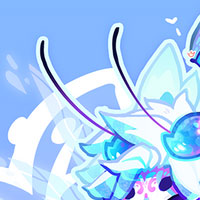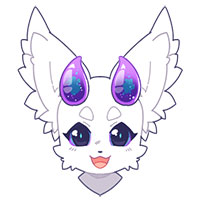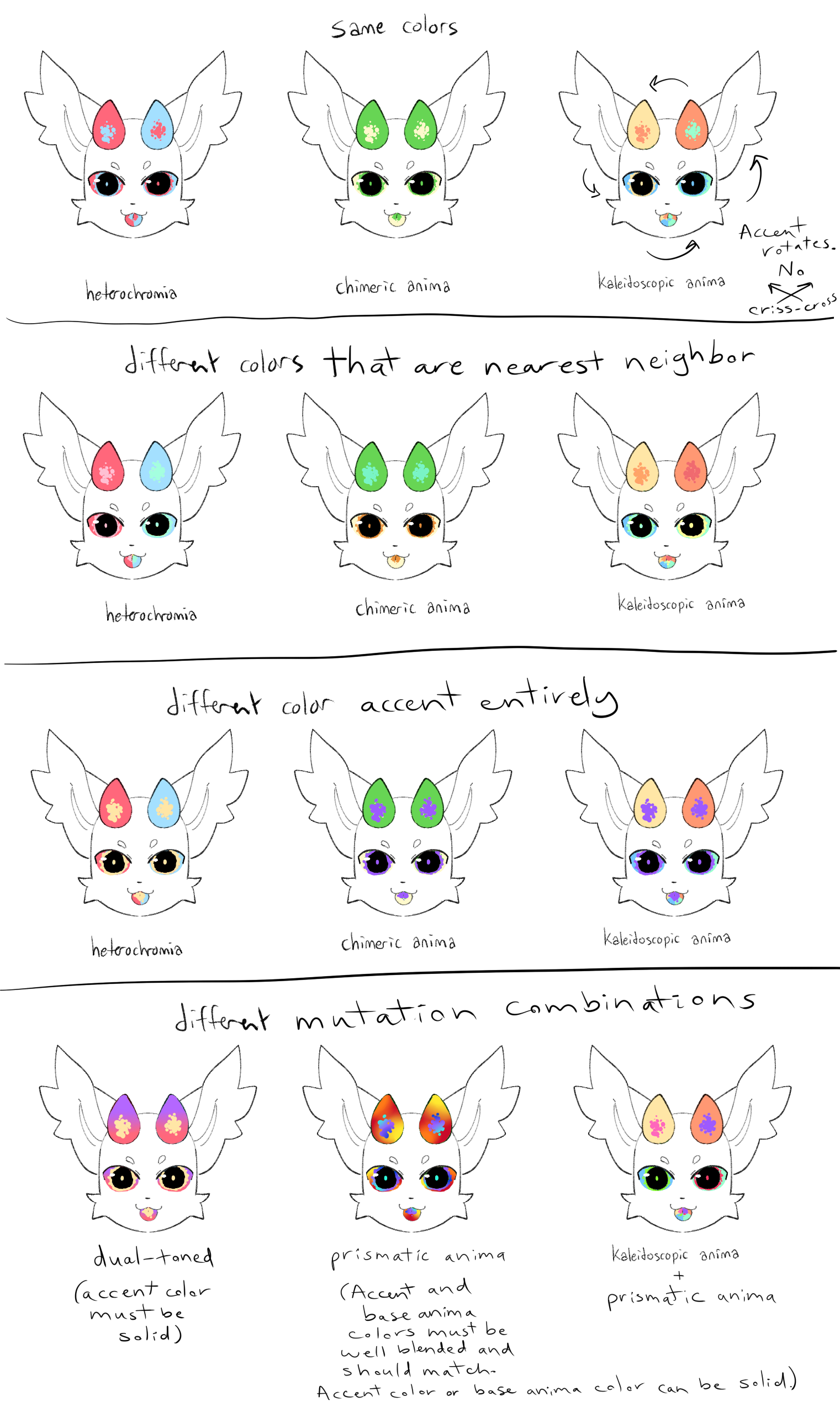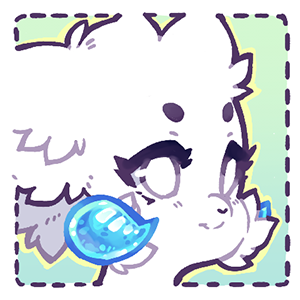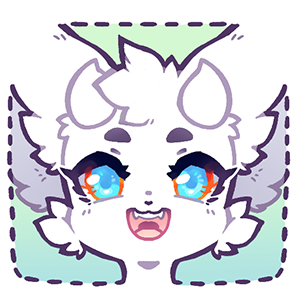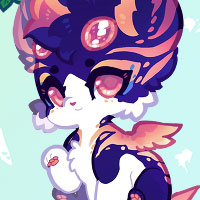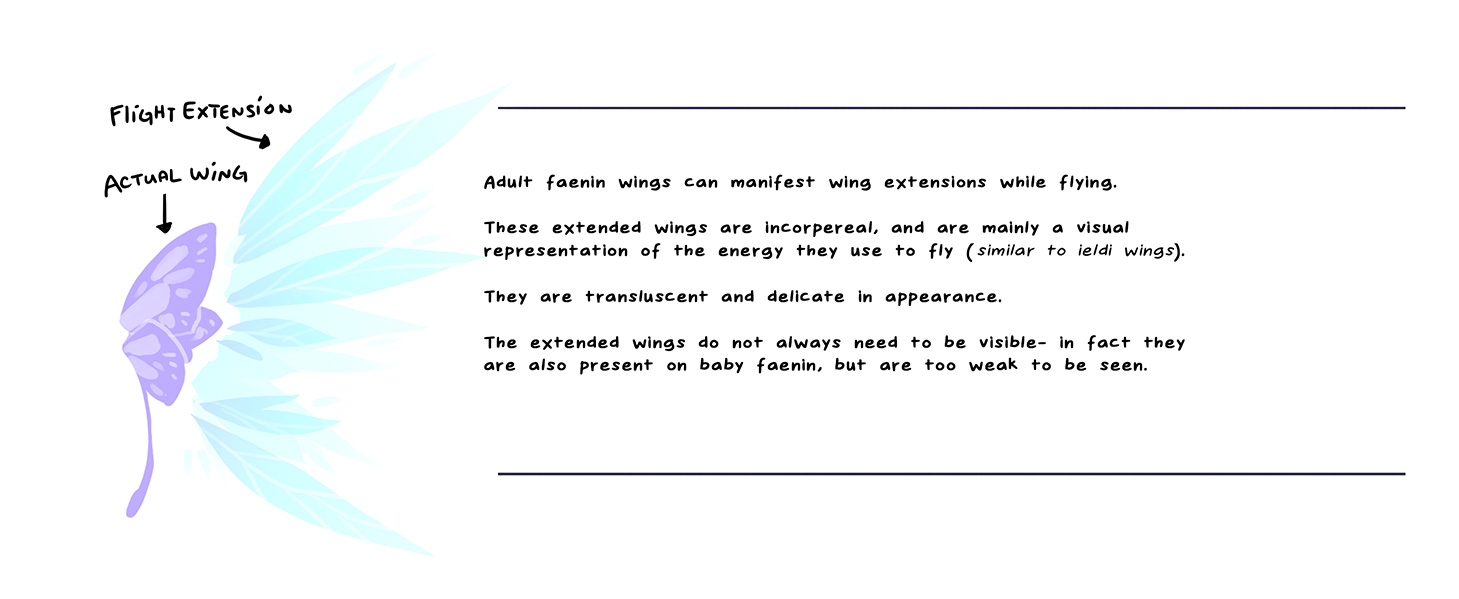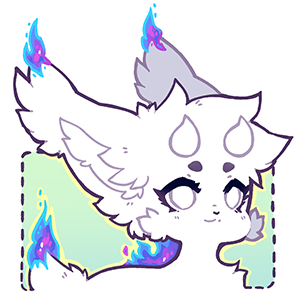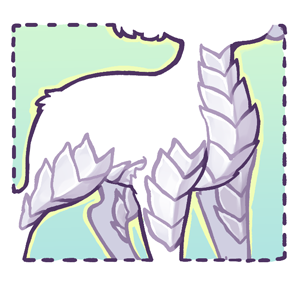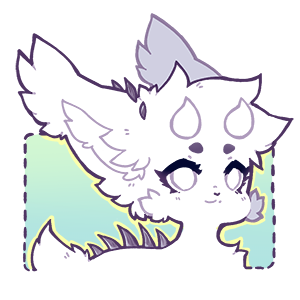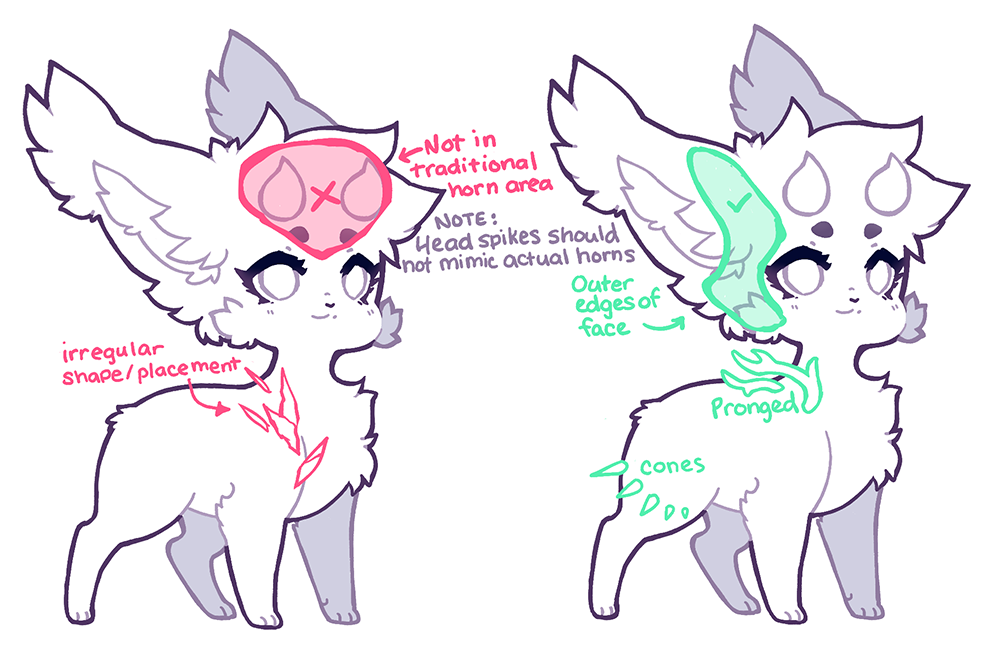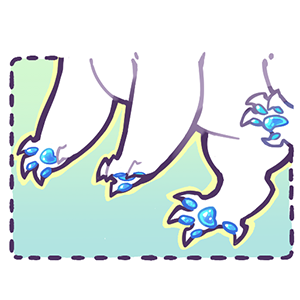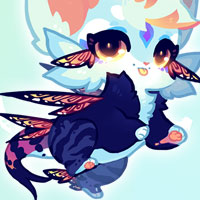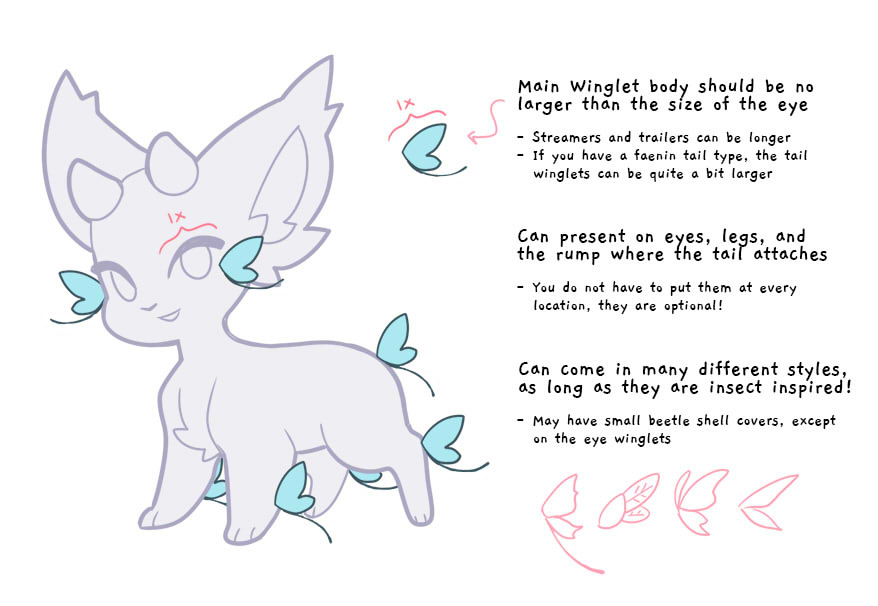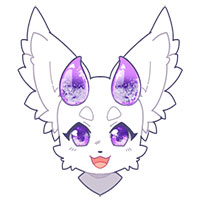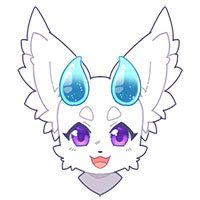Mutations
Antennae
These act as functional antennae, giving the elnin extra information about their environment: Changes in pressure (faenin make great weather predictions), ambient mana levels, etc. They aren't all-seeing, but they have generally enhanced perception compared to other elnin.
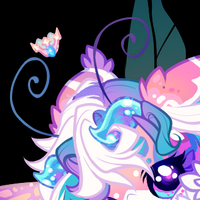 Butterfly w/ Curl
Butterfly w/ Curl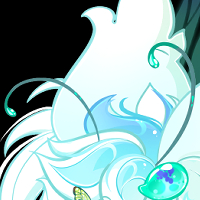 Butterfly w/ Club
Butterfly w/ Club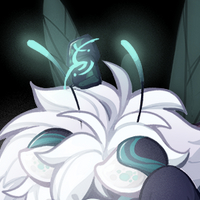 Butterfly w/ Luminous
Butterfly w/ Luminous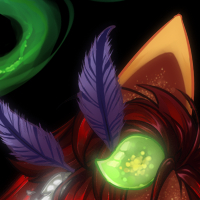 Moth Standard
Moth Standard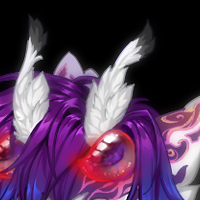 Moth w/ Petite Ears
Moth w/ Petite Ears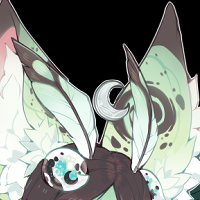 Moth w/ Oversized Ears
Moth w/ Oversized EarsDetails:
Moth Antennae are soft and fuzzy feelers. These should not be longer than standard ears even if oversized ears are present. Moth antennae should be a standard fuzzy oval/leaf-like shape, if you're seeking a different shape check the "Alternate Antennae" detail below!
- Butterfly Antennae are slender and delicate feelers with a club at the end. The luminous anima mutation will cause the club on these antennae to glow (must be anima or fae accent color). These antennae are capable of curling and can be longer than standard ears.
- Alternate Antennae are antennae that fall outside the two standard antennae shapes. These will be checked on a case-by-case basis! If you're curious if antennae existing on real insects will work for a faenin antennae shape, please include a reference image in your design approval comments and be patient. Not all antennae shapes may be allowed.
- What can affect any antennae?
- Crystallization
Dew Drop Horns
Dew drop horns sit like smooth little water droplets where an elnin's horns usually would be with one small additional droplet of anima right in the center of an elnin's forehead.
 Standard
StandardDetails:
- On adult elnin dew drop horns similar in size to standard elnin horns and only the central dew drop horn is smaller. On kittoms, the center dew drop horn is a little larger than it would be on an adult nin.
- These horns are always smooth and never come to a point.
- Horn shape can be round, teardrop, oval, or diamond shaped.
- If horns are a teardrop, oval, or diamond shape they must be oriented vertically with an optional slight bit of tilt. An inner or outer tilt overall is ok.
- Shape and orientation of the shape should be consistent.
- Teardrop horns should never be horizontally oriented or resemble additional eyes. Other anima mutations cannot be used to add or imply pupils on elnin horns, if this occurs staff will request the horn mutations be adjusted.
- These horns should have no hard facets even when diamond shaped.
- What can affect dew drop horns?
- YES: Anima mutations.
- NO: General body suffusion mutations.
- If any mutations are not listed here then we have no definitive answer for it. Please check with us first before going forward if the mutation is not on the list or you are unsure how something might work.
Doe-eyes (Fae)
This mutation is characterized by huge, dilated pupils and an iris that takes up the entire eye. The sclera is not visible and there is a distinct ring of color and freckling around the pupil in the fae accent color. This accent color is also visible as speckling in the core of the horns.
There is also a noticeable spark of light within the depths of the pupil that marks an ability to see through Faefolk illusions.
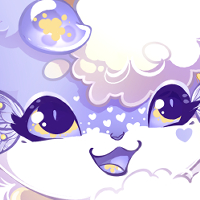 Standard
Standard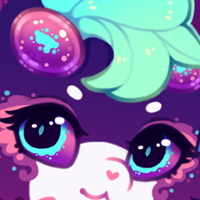 Dual-toned Anima
Dual-toned Anima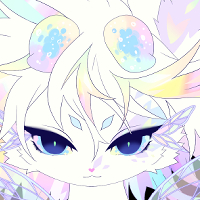 Prismatic Anima
Prismatic Anima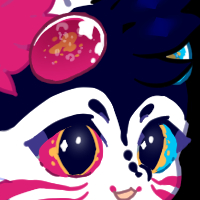 Heterochromia
Heterochromia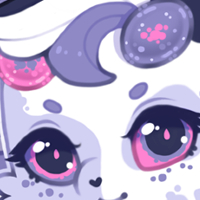 Odd-eyed
Odd-eyed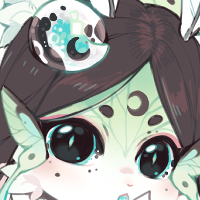 Sectotal Heterochromia
Sectotal Heterochromia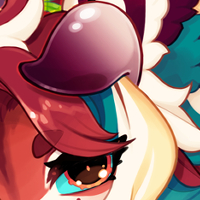 Opaque Horns w/
Opaque Horns w/ Chimeric & Prismatic Anima
Details:
- Keep in mind that since the large area in the center of the eye is actually the pupil, it always needs to be black or very close to black. You can have a tint of color to match your elnin's eyes better but it should appear black at a glance.
- The spark of light (sometimes referred to as glint) in the center of the pupil must match the anima colour/accent color or be a close neighbour color.
- So, what does the doe-eyes accent color affect?
- ALWAYS: Horns and Eyes
- POSSIBLE: Mouth (with Mana Saturated), Toe Beans, Antennae
- NEVER: Puca Tail, Crystallization, Splintered Anima, Emberglow Anima, Emberglow Suffusion
- If any mutations are not listed here then we have no definitive answer for it. Please check with us first before going forward if the mutation is not on the list.
Notes:
This mutation is only inheritable directly from faenin (must explicitly list "faenin" as a subtype on their masterlist entry). Normal elnin with doe-eyes (fae) can only pass on the standard version of the doe-eyes mutation to their children.
Fiendish Horns
Fiendish horns are small horns that wrap around the sides of an elnin's face near their cheeks. These horns taper smoothly into the back of the skull lower down, close to the point where an elnin's neck meets their skull.
 Standard
StandardDetails:
- Similar in size to standard elnin horns.
- These horns will poke through any present facial fluff in the cheek area persistently and should never be fully obscured.
- The tips of these horns can point upward or downward but bulk of the horn should remain horizontal overall.
- What can affect fiend horns?
- YES: Anima mutations.
- NO: General body suffusion mutations.
- If any mutations are not listed here then we have no definitive answer for it. Please check with us first before going forward if the mutation is not on the list or you are unsure how something might work.
Gills
Gills are delicate slit or filament-like projections that appear near either the neck or ribcage of the elnin.
 Standard
StandardDetails:
- Gills can be similar to narrow slits like those seen on sharks.
- Alternatively, gills can appear externally as shelves, frilled shelves, ribbon, or filament-like projections one might see on aquatic creatures like axolotl. Ribbon stylization can be combined with a frilled shelf gill style to create a "jellyfish" type of look.
- Gill length should only slightly exceed the length of what is allowed for common fluff mutations but never be longer than a standard ear length.
- If gills are present, breath mutations can be adjacent to the gilled areas as long as other traits are not heavily obscured.
- Additional Note: We understand that keeping gills appearing finny may be a challenging task and that some interpretations may appear to border on looking feather-like or plant-like.
- We ask an effort to differentiate gills from feathers be made by group members. Staff may recommend adjustments if needed. In general we want mutations and subtypes to be somewhat distinct from one another so we're asking that finny features not intentionally mimic feathers.
- For gills that appear reminiscent of plants, we just ask that specific plant textures be avoided in these areas. We know some gills may have plant motifs to them but they are still to remain gills or tendrils and not actual plants.
Limbal Accents
This mutation is characterized by a djinn accent-colored ring that appears around the outer edge of the iris, and is sometimes accompanied by short slashes, circles or half circles that overlap and are the same color as the rest of the limbal accent ring.
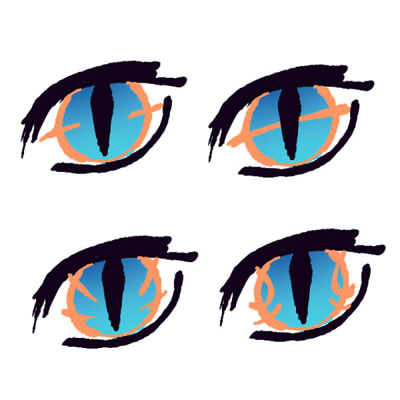 A few examples
A few examplesDetails:
- These accents should not depict any text/runes/sigils/clearly identifiable symbols.
- These accents should not have any lineart.
- This accent does not appear in or overlap an elnin's pupil, nor will it ever obscure an elnin’s entire sclera on its own.
- Some of the small short slashes, half circles, or circles that meld into the limbal ring can overlap the sclera and iris as long as they are overlapping the required overall accent ring.
- Limbal accent color does not affect any other anima mutations.
- So, what does the limbal accent color affect?
- ALWAYS: Just the eyes
- POSSIBLE: Mouth lineart (with Mana Saturated), Toe Beans (the lineart or edge of each toe bean would optionally mirror the accent color)
- NEVER: Crystallization, Splintered Anima, Emberglow Anima, Emberglow Suffusion
- If any mutations are not listed here then we have no definitive answer for it. Please check with us first before going forward if the mutation is not on the list.
Notes:
This mutation is only inheritable directly from djinnin (must explicitly list "djinnin" as a subtype on their masterlist entry).
Miniature Wings
Standard miniature wings are small nonfunctional wings. Elnin with miniature wings cannot actually fly, as they are too small, but they sure are cute!
The faenin variant of miniature wings is always accompanied by the arcane Faerie's Boon on masterlist entries, which allows for flight for faenin with miniature wings. If this boon is not present then the elnin cannot fly with faenin miniature wings! You can find more about it in Flight under the Faerie's Boon section!
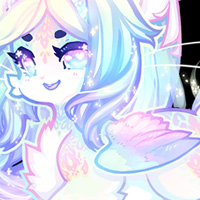 Feathered
Feathered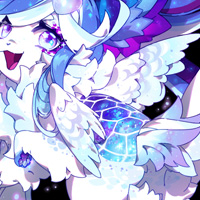 Feathered
Feathered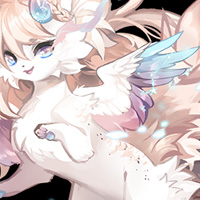 Max Size Feathered
Max Size Feathered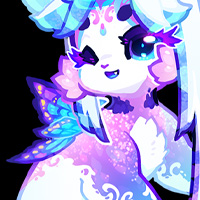 Fae
Fae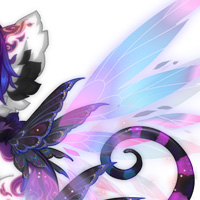 Fae with Flight Extensions
Fae with Flight Extensions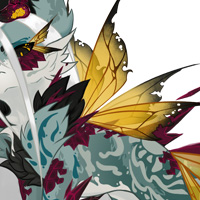 Fae with Mana Corruption
Fae with Mana CorruptionDetails:
- Miniature wings should be kept smaller than the length of the body and be able to fit within the elnin's torso if overlayed.
- Miniature wings should mirror one another and be symmetrical.
- What can affect miniature wings?
- YES: Starlit Suffusion, Emberglow Suffusion, Luminous Suffusion, Shimmering Suffusion, Iridescent Suffusion, Metallic Suffusion, Crystallization, Splintered Anima (Can cause winglets to look tattered, but anima splinters should not be present on the winglets themselves. The only exception to this would be if there is underlying bone or muscle in a specific spot that the splintering is originating from, like feathered or batwing-like miniature wings have.)
- NO: Anima mutations, aside from the effect from splintered anima stated above.
- Splintered Anima specific miniature wing guidelines:
- Can optionally create a tattered look to the miniature wing mutation (and winglets).
- Splintered anima being present allows for tears in Miniature Wings (Fae / Fiendish) or damaged feathers in Miniature wings (Feathered).
- On normal wings, there shouldn't be any sections of the wings that look like it could fall off, such as any bits hanging off the middle section of the wing that appear to be partially detached. Imagine a peninsula but with a noticeable cinch point where a frayed piece is just barely hanging onto the wing.
- Splintered anima being present allows for small, irregularly-placed holes to appear in miniature wings.
- Tears and holes from the presence of the splintered anima mutation mean that there can be subtle differences in the wing's silhouette. For example, one wing could be more tattered than the other and have tears or holes in different places.
For Faenin / Miniature Wings (Fae):
- The miniature wings would be butterfly or moth-like, and labeled "Fae".
- For faenin miniature wings, the main bulk of the wing should follow the "smaller than the length of the body" rule mentioned above. However, streamers and trailers can be longer.
- For faenin miniature wings, the wings still must mirror one another. This means each wing should have a similar silhouette if layered over the other wing.
- The faenin variant of miniature wings appears on elnin with the faenin subtype, and is always accompanied by the arcane Faerie's Boon on masterlist entries, which allows for flight for faenin with miniature wings. If this boon is not present, then the elnin cannot fly with faenin miniature wings! You can find more about it in Flight under the Faerie's Boon section!
For Djinnin / Miniature Wings (Fiendish):
- The miniature wings would be batwing-like, and labeled "Fiendish".
- The fiend variant of miniature wings appears on elnin with the djinn subtype is always accompanied by the arcane Fiend's Boon on masterlist entries, which allows for flight for djinnin with miniature wings. If this boon is not present then the elnin cannot fly with fiendish miniature wings! You can find more about it in Flight under the Fiend's Boon section!
For Undine / Miniature Wings (Finned):
- The miniature wings would be fin-like.
- Cuttlefish style frills, frilled tendrils with a bell where they connect to the body, or a short small connected group of thick tendrils can be added in place of other fins or finlets. Thick tendrils must be shorter and connected so they read as a cohesive 'fin' substitute and not additional limbs.
- The finned variant of miniature wings appears on elnin with the Undine subtype is always accompanied by the arcane Swimmer's Boon on masterlist entries, which allows for flight-like agility in water for Undine with miniature wings. If this boon is not present then the elnin cannot tread water or perform aerodynamic leaps above the water with finned miniature wings! You can find more about it in Flight under the Swimmer's Boon section!
- Additional Note: We understand that keeping fins appearing finny may be a challenging task and that some interpretations may appear to border on looking feather-like or plant-like.
- We ask an effort to differentiate fins from feathers be made by group members. Staff may recommend adjustments if needed. In general we want mutations and subtypes to be somewhat distinct from one another so we're asking that finny features not intentionally mimic feathers.
- For fins that appear reminiscent of plants, we just ask that specific plant textures be avoided in these areas. We know some fins may have plant motifs to them but they are still to remain fins or tendrils and not actual plants.
For ??? / Miniature Wings (Feathered):
- The miniature wings would be birdwing-like, and labeled "Feathered".
Notes:
- If your elnin's miniature wing type is not specified please submit a support ticket to clarify which miniature wing type your elnin has. If a wing type is not specified, this does not mean you can choose any miniature wing type. Staff will have to determine which type your elnin was granted and make sure that detail is specified on the masterlist before a design approval goes through for that elnin.
Pilot Lights
Small flames that can appear at an elnin's ear tips, tail tip, or halfway down their spine. See details section for coverage specifics.
 Standard
StandardDetails:
- Flames have to be on the elnin and cannot be free floating.
- Flames can be present either at the tips of the ears, partially along their back, as a small flame near the tip of an elnin's tail, or some combination of the three locations. Any flames near an elnin's back can only go partially down their spine. This will only affect about 50% of an elnin's back, and never go fully down their back without the spinal ridge mutation present.
- Flames should be kept relatively small no matter where they are present. Roughly the size of an elnin's eye width or height wise before the flames start to taper.
- Flames are limited to one spot per body part. So they will not appear in multiple places on a single tail, ear, or elnin's back.
- Flames will not replace entire parts of tails or limbs, so you would not see a grove tail looking like the end tuft is entirely engulfed in flame. Only the very tip of the tail tuft might be, or the very tip of another tail style like meadow or welkin.
- This trait is not anima-based and therefore not dependent on an elnin's anima color (like the fire breath mutation which comes from within an elnin).
- Can be any color, but have a tendency to gravitate towards the color of other present flame-aesthetic mutations.
- This is not a requirement, but flavor-wise, pilot lights will have a tendency to match witchlight crown color or fire breath color if one or both of those mutations are present.
- Pilot lights can be a consistent gradient of multiple colors, or each flame can be a different solid color.
- Flame color should not change or transition, and should always be depicted in a static way. The colors will not change, transition, or swap places.
- For example: If you have a blue to pink to yellow gradient on each flame, where blue is on the bottom of the flame and yellow is on the top, the flames will always be blue on the bottom and yellow on the top in any picture.
- Solid identifiable shapes of color will never appear on pilot lights, only gradients of color where applicable.
- What can affect the pilot lights mutation?
- YES:Body suffusion mutations that float around the body would affect this mutation, but these mutations must also affect other non-pilot light areas of the body. (Starlit suffusion, emberglow suffusion). Spinal ridge allows the spinal ridge to be fully replaced by small flames if flames are present anywhere on an elnin's back.
- NO: Anima mutations would not affect pilot lights. (You could do a similar gradient to an anima color mutation but it wouldn't be required since pilot lights are not anima-based. Also colors still need to follow the pilot light guidelines mentioned under the details section above.)
Pixie Horns
Faenin horns are positioned at the top of the head, curving forward and up toward the end.
Plate Scales
Plate scales are larger scales similar to those you might find on a snake's underbelly, like "belly scutes". These scales are generally larger and wider.
 Standard
StandardDetails:
- Are large and generally more rectangular in shape (like snake belly scutes) or similar to a wide "V" shape, but shape can vary slightly. Plate scale shape cannot imitate heavily inorganic shapes (man-made objects) or elemental shapes. (Plants/wood, flames, water, multi-faceted crystals, etc.)
- Plate scales generally sit in rows overlapping one another, like you would see plated armor.
- Plate scales should not cover more than 50% of the elnin.
- Plate scales most often appear on the belly and legs of elnin but can occur in other areas on the body as well but, like standard scales, are generally more sparse on the tail.
- Tails will never be fully scaled with this mutation, unless a rarer scaled tail style like Overwild (Aquatic) is already present on an elnin.
- Plate scales should be three dimensional and rendered either with or without lineart.
- Plate scales can at times have small anima accents between the plate scaling, almost appearing like small gems due to how they’re minimal and set in the narrow gaps. These anima accents can show anima mutations. (Fx from anima mutations are very very localized to just the gap areas and don't have much spread.)
- These anima accent areas are not required on plate scales though, so if you wanted to broadly have a suffusion mutation around you could add the suffusion mutation generally around plate scaled areas as well, but it can't only be present in just those areas/should still be present and generally dispersed across the body elsewhere too.
- The large scales themselves should not imitate gems or markings. They must be distinctly read as scales. Similar to standard scales, the larger plate scales are not made of anima.
- What can affect plate scales?
- YES: Body suffusion mutations, such as metallic suffusion, shimmering suffusion, iridescent suffusion, starlit suffusion, emberglow suffusion, and luminous suffusion. Body suffusion mutations cannot only affect plate scales and must also be present in other locations.
- NO: Anima mutations would not affect scales outside of the accent gems that are attached. (*Unless crystallization is present on the plate scales, in which case anima mutations would be localized on plate scales and any related effects would be in very very close proximity to the plate scales themselves.)
Polycoria
This mutation is characterized by an elnin having 2-4 pupils in the center of their eyes.
 A few examples
A few examplesDetails:
- Pupil shape should be consistent across both eyes.
- Keep in mind that the pupils always need to be black or very close to black, or white. If the pupils are black, they can have a tint of color to match your elnin's eyes better but it should appear black at a glance.
- What can affect polycoria?
- YES: Some anima mutations can affect the iris around the pupils like Starlit anima, Emberglow anima, Heterochromia, Chimeric anima., Prismatic anima, Grafted anima, Kaleidoscopic Anima, Luminous anima, Dual-toned anima, Anima patterning, and Decora anima.
- Decora anima can also interact with polycoria pupils to change their color but the total number of colors present across all eyes and horns should not exceed 2 when positional mutations are present, unless all decora anima spots are the single same color.
- Heterochromia can allow for eyes to have different pupil shapes, different pupil placements, and a different number of pupils (as long as one eye has no more than 4 pupils and no less than 2). Keep in mind the iris color will still be affected by heterochromia too, with the right horn and eye being one color and the left horn and eye being a different color.
- NO: Doe-eyes, Doe-eyes (Fae)
- YES: Some anima mutations can affect the iris around the pupils like Starlit anima, Emberglow anima, Heterochromia, Chimeric anima., Prismatic anima, Grafted anima, Kaleidoscopic Anima, Luminous anima, Dual-toned anima, Anima patterning, and Decora anima.
- If any mutations are not listed here then we have no definitive answer for it. Please check with us first before going forward if the mutation is not on the list.
Notes:
This mutation is only inheritable directly from undine elnin (must explicitly list "undine" as a subtype on their masterlist entry).
Spikes
A spiked elnin has small, opaque, smooth but hard projections that can develop on their body.
 Standard
StandardDetails:
- Similar to scales, spikes are not made of anima.
- Spikes are smooth and solid in texture, and opaque in appearance. These projections do not have a firm gummy quality to them like elnin horns do, and are much tougher since they aren't anima. (Don’t poke anyone’s eye out!)
- Spikes cannot imitate heavily inorganic shapes (man-made objects like lamp covers, hearts, etc.) or elemental shapes. (Plants/wood, flames, water, multi-faceted crystals, etc.)
- Can be pronged (up to 2-3 prongs tops). Be mindful that above details apply, and spikes should never read as full blown horns (like moose or complex stag horns). These are still just body spikes.
- Overall spike size should be kept relatively small, no larger than an elnin's head width. If any spikes on an elnin's head appear to be strongly imitating horns of any subtype/kind, we may request they be adjusted. In general, while it's not required, we would recommend head spikes err smaller than other body spikes to try to avoid anything reading too much like a horn.
- Spikes display in organized and consistent ways. You will always see a smooth transition or consistent pattern for how the spikes look and occur. Spikes will never be irregularly-shaped, broken/cracked, jagged and/or scattered arbitrarily (like you would see for splintered anima).
- Can be asymmetrical in broad placement. For example, the spikes could run up just one arm and down an elnin's back (as long as shapes are consistent and organized), or appear in a balanced way on a front ankle and opposite back ankle.
- Should not cover more than roughly 50% of an elnin's body and cannot obscure other traits or the bulk of an elnin. If this mutation is heavily obscuring traits or other mutations, edits may be requested.
- This trait cannot be used to imitate other traits period. This holds true for any mutation, but we want to be extra clear, if we see spikes being placed on the shoulders (or winglet locations) and made to imitate wing-like projections of any kind we will ask that they be removed.
- Previously this trait was called "Barbed Tail".
- What can affect the spikes mutation?
- YES: Body suffusion mutations, such as metallic suffusion, shimmering suffusion, iridescent suffusion, starlit suffusion, emberglow suffusion, and luminous suffusion. Body suffusion mutations cannot only affect spikes and must also be present in other non-spiked locations.
- NO: Anima mutations would not affect spikes (*Unless crystallization is present on the spikes, in which case anima mutations would be localized on the spikes and any related effects would be in very very close proximity to the spikes themselves. Be careful this combination does not read as irregular or like splintered anima, otherwise our staff will request changes.)
Talons
An elnin's paws gain a distinct shape with sharp talons for claws.
 Standard
StandardDetails:
- An elnin with talons is an elnin whose entire foot shape has been adjusted. Their feet are less paw-like and have slightly longer taloned toes that can grasp things better.
- This change can occur on a single paw, or any number of an elnin's paws.
- Talon claws are independent of an elnin's anima and will be opaque and solid, with more natural claw colors like black, white, ivory, or brown. Alternatively, if the claws are not distinctly lined and blend into the foot, then they can be the same color as the rest of the base foot color.
- Previously this trait was called "Djinn Peets".
- What can affect the talons mutation?
- YES: Infused teeth/claws (this can allow the talon claws to be anima colored). General body suffusion mutations such as metallic suffusion, shimmering suffusion, iridescent suffusion, starlit suffusion, emberglow suffusion, and luminous suffusion. Body suffusion mutations cannot only affect talons and must also be present in other locations on the body. Keep in mind suffusion mutations cannot imitate phantom step, so any effects should be on the top of the foot or higher, never beneath the feet themselves.
- NO: Anima mutations (without infused/teeth claws also present, and even in those cases only color is impacted, no effects will show floating around the claws themselves.)
- YES: Infused teeth/claws (this can allow the talon claws to be anima colored). General body suffusion mutations such as metallic suffusion, shimmering suffusion, iridescent suffusion, starlit suffusion, emberglow suffusion, and luminous suffusion. Body suffusion mutations cannot only affect talons and must also be present in other locations on the body. Keep in mind suffusion mutations cannot imitate phantom step, so any effects should be on the top of the foot or higher, never beneath the feet themselves.
Winglets
Winglets are small, non-flight-related wing-like adornments that can appear on the arms, legs, around the eyes, or at the base of the tail.
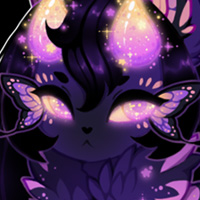 Eye Winglets (Fae)
Eye Winglets (Fae)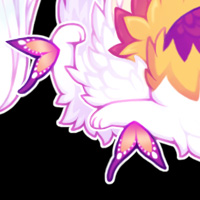 Leg Winglets (Fae)
Leg Winglets (Fae)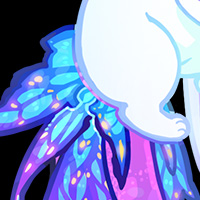 Large Tail Winglets (Fae) w/ Fae Tail
Large Tail Winglets (Fae) w/ Fae TailDetails:
- Attachment points for winglets are on the arms, legs, rump (where the tail attaches), and eyes. Winglets around the eyes can be slightly above the eyes at the earbase or slightly below the eye near the cheeks.
- The main body of the winglets should be about the same as the size of the eye or smaller.
- Fine streamers and trailers can be longer.
- If your elnin has a subtype tail type (Flare, Bulb, or Whip), then the winglets at the tail base can be larger than winglets present in other areas. Just keep these winglets reasonably proportioned to the tail itself.
- All the winglets do not have to be the same size. You can make them smaller or larger as you prefer.
- What can affect winglets?
- YES: Starlit Suffusion, Emberglow Suffusion, Luminous Suffusion, Shimmering Suffusion, Iridescent Suffusion, Metallic Suffusion, Crystallization, Splintered Anima (can cause winglets to look tattered, but anima splinters should not be present on the winglets themselves).
- NO:Anima mutations, aside from the effect from splintered anima stated above.
- If any mutations are not listed here, then we have no definitive answer for it. Please check with us first before going forward if the mutation is not on the list.
- Winglets will always have an associated subtype listed if they are on a standard elnin, or match an elnin's subtype if they are on an elnin with a subtype. Winglets inherited from a pure subtype elnin will always match a parent’s subtype.
For Faenin / Winglets (Fae):
- The winglets would be butterfly or moth-like, and labeled "Fae".
For Djinnin / Winglets (Fiendish):
- The winglets would be batwing-like, and labeled "Fiendish".
For Undine / Winglets (Finned):
- The winglets would be fin-like.
- Cuttlefish style frills, frilled tendrils with a bell where they connect to the body (on the eyes the bell part is optional), or a short small connected group of thick tendrils can be added in place of other fins or finlets. Thick tendrils must be shorter and connected so they read as a cohesive 'fin' substitute and not additional limbs.
- Additional Note: We understand that keeping fins appearing finny may be a challenging task and that some interpretations may appear to border on looking feather-like or plant-like.
- We ask an effort to differentiate fins from feathers be made by group members. Staff may recommend adjustments if needed. In general we want mutations and subtypes to be somewhat distinct from one another so we're asking that finny features not intentionally mimic feathers.
- For fins that appear reminiscent of plants, we just ask that specific plant textures be avoided in these areas. We know some fins may have plant motifs to them but they are still to remain fins or tendrils and not actual plants.
For ??? / Winglets (Feathered):
- The winglets would be birdwing-like, and labeled "Feathered".
Notes:
- This mutation is only inheritable directly from a subtype (for example an elnin must explicitly list "Faenin", "Djinnin", or "Undine" as a subtype on their masterlist entry). Normal elnins with Winglets (fae) or another subtype-associated winglet cannot pass on any type of winglets to their kittoms since there is no "standard" version of this trait.
- If your elnin's winglet type is not specified please submit a support ticket to clarify which winglet type your elnin has. If a winglet is not specified, this does not mean you can choose any winglet type. Staff will have to determine which type your elnin was granted and make sure that detail is specified on the masterlist before a design approval goes through for that elnin.
Anima Patterning
Distinct symmetrical patterning on or within the surface of the anima - textures/frosting/etc. Not to be confused with the Knight engravings which are runic in nature. Anima patterns should not look like symbols/sigils, and should be present on both eyes/horns equally.
Details:
- Can only be a darker or lighter shade of the anima color.
- Can be transparent or slightly more opaque.
- Must be uniform across the entire surface of the eye.
- The only exception being a "frosted"/"iced" texture which is holdover from legacy stuff but must at least be present uniformly across all eyes even if it's only across a portion of the eye.
Bioluminescent Coat (Legacy)
(legacy trait - retired. Existing "Bioluminescent Coat" mutations will instead potentially pass on "Luminous Markings" to offspring)
Black Sclera (Legacy)
(legacy trait - retired. Existing hereditary "Black sclera" mutations will instead potentially pass on "Infernal Gaze" to offspring)
Bubble Breath
Allows an elnin to blow bubbles. It's not particularly useful for anything specific, but it can make for some fun entertainment and a cute display.
 Standard
Standard Standard
StandardDetails:
- Bubble color should match anima color (will also display starlit anima mutation if present).
- Bubbles appear as round transparent orbs, sometimes two or will stick together while others float off.
- The bubble trail must not stray further than 2 body lengths.
- If the gills mutation is present on an elnin, breath mutations can be adjacent to the gilled areas as long as other traits are not heavily obscured.
- What can affect bubble breath?
- YES: Anima mutations can impact the color of breath mutations. Starlit anima specifically can add a starlit effect on the breath itself, but keep in mind this effect does not alter the shape of the breath so the breath’s silhouette and general appearance would still be bubble-like. Emberglow anima can affect the breath but the motes should remain anima colored and stick very close/immediately surrounding the breath with little drift. Chimeric anima can display as either colour or a gradient of both. Prismatic anima must display all the colors in the prism.
- NO: General body suffusion mutations.
Celestial Shroud
This happens when the mana filaments that make up an elnin's hair are constantly phasing through various densities, or dissolving entirely to release small amounts of surface mana into the air. This gives the hair an ethereal, shimmering appearance accented by tiny points of diffracting light. It can also cause sections of hair to take on an auroral aspect as mana released by dissipating filaments coalesces into delicate sheets of iridescent color and light. This normally only happens for a short moment when an elnin is consciously changing the length of their hair, and is generally not a sustainable effect. However, some elnins exhibit this visually striking state of flux at all times.
Details:
- Celestial Shroud affects hair and tail styles with longer strands in areas.
- Celestial Shroud can impact all tail styles except for Marsh and warren.
- Celestial Shroud does not give all of the hair strands a weightless quality, only those that are in flux/semi-transparent will have any lift but all other hair should be grounded. If you'd like the hair to also have a weightless quality then you'll need to add the featherlight mutation.
- Celestial Shroud should not have any lineart on it.
Notes:
- Historically this mutation did not affect fluff mutations and read "Fluff mutations should not be long enough to display this mutation." Fluff mutations are now permitted to show this mutation if fluff strands can depict it in a clear way.
Chimeric Anima
When an elnin's anima presents two core colors in a particular configuration: Horns show one color, while eyes show secondary color. Skeleton color is usually divided with the horn color on the top half, and the eye color on the bottom.
Details:
- What can affect Chimeric Anima?
- YES: Prismatic Anima, Starlit Anima, Emberglow Anima, Decora Anima, Grafted Anima, and Patterned Anima.
- NO: Kaleidoscopic Anima, Odd-eyed, Heterochromia, Dual-toned Anima, and anything else not listed under YES.
- YES: Prismatic Anima, Starlit Anima, Emberglow Anima, Decora Anima, Grafted Anima, and Patterned Anima.
- If any mutations are not listed here then we have no definitive answer for it. Please check with us first before going forward if the mutation is not on the list.
Lore:
- This is considered an unbalanced alignment, implying that one aspect of an elnin's energy is more dominant than the other. There are arguments that suggest the eye color is dominant because the more potent energy is "heavier" and settles below, while others argue the horn color is truly dominant because it is actively suppressing its counterpart.
